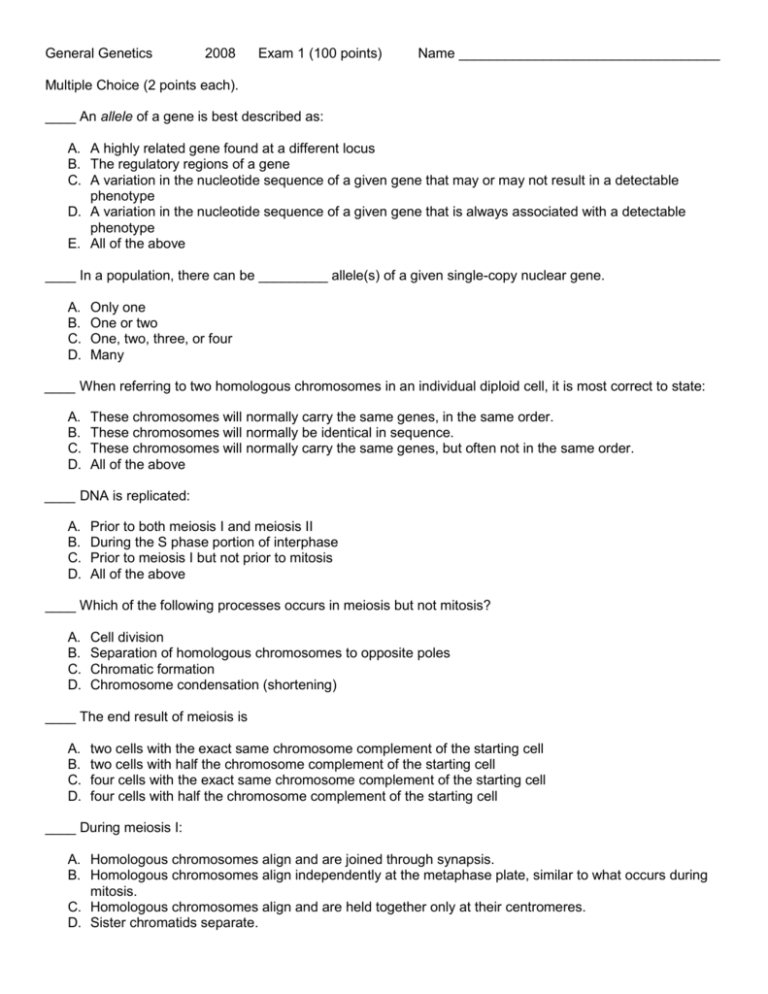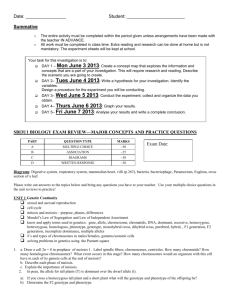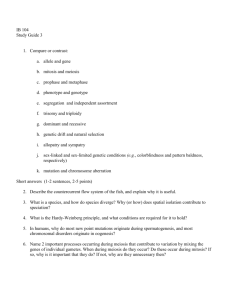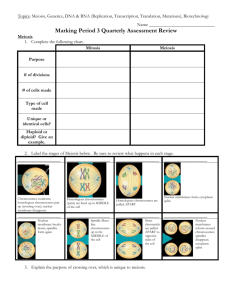BioSc 231 Exam 1 2008
advertisement

General Genetics 2008 Exam 1 (100 points) Name __________________________________ Multiple Choice (2 points each). ____ An allele of a gene is best described as: A. A highly related gene found at a different locus B. The regulatory regions of a gene C. A variation in the nucleotide sequence of a given gene that may or may not result in a detectable phenotype D. A variation in the nucleotide sequence of a given gene that is always associated with a detectable phenotype E. All of the above ____ In a population, there can be _________ allele(s) of a given single-copy nuclear gene. A. B. C. D. Only one One or two One, two, three, or four Many ____ When referring to two homologous chromosomes in an individual diploid cell, it is most correct to state: A. B. C. D. These chromosomes will normally carry the same genes, in the same order. These chromosomes will normally be identical in sequence. These chromosomes will normally carry the same genes, but often not in the same order. All of the above ____ DNA is replicated: A. B. C. D. Prior to both meiosis I and meiosis II During the S phase portion of interphase Prior to meiosis I but not prior to mitosis All of the above ____ Which of the following processes occurs in meiosis but not mitosis? A. B. C. D. Cell division Separation of homologous chromosomes to opposite poles Chromatic formation Chromosome condensation (shortening) ____ The end result of meiosis is A. B. C. D. two cells with the exact same chromosome complement of the starting cell two cells with half the chromosome complement of the starting cell four cells with the exact same chromosome complement of the starting cell four cells with half the chromosome complement of the starting cell ____ During meiosis I: A. Homologous chromosomes align and are joined through synapsis. B. Homologous chromosomes align independently at the metaphase plate, similar to what occurs during mitosis. C. Homologous chromosomes align and are held together only at their centromeres. D. Sister chromatids separate. ____ If a human trait such as red-green color blindness is never passed from father to son, this is likely an indication that the allele conferring this trait is: A. B. C. D. E. X linked Y linked Autosomal but sex-influenced Recessive Dominant The SBE1 gene in peas encodes “Starch Branching Enzyme 1.” When the dominant allele (“R”) of SBE1 is present, peas are round. The recessive allele (“r”) no longer encodes functional enzyme, due to the insertion of a fairly large segment of DNA (a transposon) in the SBE1 gene. You prepare DNA samples from three pea plants and analyze the SBE-1 gene by agarose gel electrophoresis. Your results: 1 2 3 _ + ____ If the DNA seen on gel 1 is from a pea plant heterozygous for “R” and “r” at the SBE1 locus, the DNA in lane 2 is most likely from a pea plant: A. B. C. D. E. Homozygous for the “R” allele Homozygous for the “r” allele Unable to make functional starch branching enzyme 1 That is making twice the normal amount of starch branching enzyme 1 None of the above ____ An individual displays a dominant phenotype. To determine whether the individual is homozygous for the dominant allele or heterozygous at that locus, you would best do a: A. B. C. D. E. Complementation test Epistasis test Genome sequencing analysis Testcross None of the above ____In dihybrid crosses, the ratio 9:3:3:1 indicates ___. A. Segregation of alleles B. Independent assortment C. Intermediate dominance D. Three alleles for each trait ____Chromosomes that are matched up or paired at metaphase of meiosis I are called ___? A. B. C. D. E. homologous heterologous complementary non-disjunctive parallel For the next four questions, refer to the following pedigree. The pedigree illustrated here shows individual II-2 affected with a disease that is inherited in an autosomal recessive pattern (with full penetrance). Let “A” represent the dominant allele and let “a” represent the recessive allele. ____ The genotype of I-1 must be: A. B. C. D. AA Aa aa Insufficient data to tell ____ The genotype of II-1 must be: A. B. C. D. AA or Aa AA or aa Aa or aa AA, Aa or aa ____ What is the probability that if parents I-1 and I-2 had another (4th) child, he or she would not have the disease? A. B. C. D. E. 3/4 2/3 1/2 1/3 1/4 ____ What is the probability that II-3 is heterozygous for the dominant and recessive alleles? A. B. C. D. E. 3/4 2/3 1/2 1/3 1/4 ____Pheynloketonuria (PKU) is a metabolic disorder in which the amino acid phenylalanine is toxic. PKU results from an autosomal recessive gene designated p. Two parents without PKU have a child with PKU. What is the probability that their next child will have not have PKU? What is the probability that the next child will be a boy with PKU? A. B. C. D. E. ¼; 1/8 3/4, ¼ ¼; ½ 3/4, 1/8 1/8; ¼ Short Answer (variable points). Name one human genetic disorder that is inherited in a simple Mendelian pattern (2 points) What is the purpose of “check points” during the cell cycle? (2 points) Resistance to a popular herbicide is a dominant trait in soybean. Assume that researchers at a major seed company conducted a series of experiments where herbicide resistant plants were crossed with plants sensitive to the herbicide. The following progeny were produced: 325 resistant plants and 350 sensitive plants. What is the most probable genotype of each parent? (2 points). Would the seed company want to use the resistant plants for propagating seeds to sell on the market? Why or why not? (4 points) Describe one process that occurs during meiosis that is responsible for creating genetic diversity within a population. (2 points) Huntington’s disease is due to a rare autosomal dominant gene. In a mating in which both the man and the woman have Huntington’s disease, could all the children not have Huntington’s disease? Explain. (2 point) Calculate the probability of having one girl and two boys in a family with three children. (2 point) What is the probability of having 6 girls and two boys in a family with the following birth order: GGGGGGBBB? (2 points) When Mendel conducted some of his crosses he made sure that he got the same results when he used pollen (male gametes) from the parent with the dominant trait to pollinate the carpel (female gametes) of the parent with the recessive trait and when he used pollen from the parent with the recessive trait to pollinate the carpel of the parent with the dominant trait Why? (2 points) What do you call these two types of crosses? (2 points) Draw a Punnet square for the following cross: DdHh x DdHh and circle the genotypes that will produce individuals who have both dominant phenotypes. (6 points) A breed of guinea pigs can have either black and white coloration or brown and white coloration. For each of the crosses given below, write the most probable genotype (or genotypes if more than one answer is possible) for the PARENTS. (6 points) Parental phenotypes Phenotypes of Offspring Black and white Brown and white A) black and white x brown and white B) black and white x brown and white C) black and white x black and white Cross A 12 29 19 Cross B 14 0 7 Cross C The following diagram shows chromosomes in either anaphase of mitosis or anaphase I or II of meiosis. The organism has a diploid number of (2n=4). In other words it has two copies of two different chromosomes (A,a and B,b). Cross out those chromosome arrangements that are not possible (ignoring crossing over) and for those that are possible, indicate which stage of mitosis or meiosis is represented. (8 points) A. . C. . D. . B. .. Assume that a certain organism has a diploid number of 2 pairs of chromosomes (2n=4) in its body cells and that these chromosomes may be referred to as the A, a chromosomes and the B, b chromosomes. Identify, from the choices given below, the stage of mitotic or meiotic cell division for each diagram. (8 points) Choices: (each may be used more than once or not at all) A. B. C. D. E. F. Interphase Anaphase of mitosis Metaphase of mitosis Anaphase I or meiosis Anaphase II of meiosis Metaphase II of meiosis









